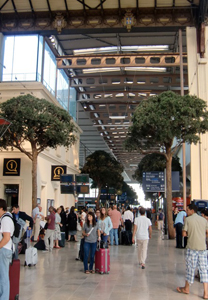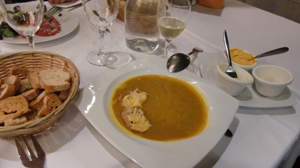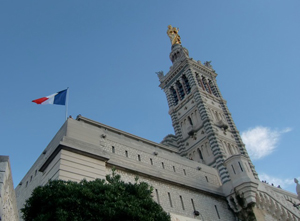Sipping Pastis in Marseille


- SUBSCRIBE
- ALREADY SUBSCRIBED?
BECOME A BONJOUR PARIS MEMBER
Gain full access to our collection of over 5,000 articles and bring the City of Light into your life. Just 60 USD per year.
Find out why you should become a member here.
Sign in
Fill in your credentials below.
 Its reputation may be tarnished, but Marseille offers travellers pretty much everything; sunny skies, art, terrific food and a rich diverse history dating back more than 2000 years. Marseille was not a destination that I had initially considered, but it was a starting point before going to Cassis for a beach holiday. You can take the rapid train (TGV) from Paris and arrive in Marseille in three and a half hours. This is an easy trip especially if you have a certain appreciation for train travel.
Its reputation may be tarnished, but Marseille offers travellers pretty much everything; sunny skies, art, terrific food and a rich diverse history dating back more than 2000 years. Marseille was not a destination that I had initially considered, but it was a starting point before going to Cassis for a beach holiday. You can take the rapid train (TGV) from Paris and arrive in Marseille in three and a half hours. This is an easy trip especially if you have a certain appreciation for train travel.
Upon arriving at the Marseille train station, you’ll immediately notice the trees that are growing in the station. That’s when I decided that I was going to like this city that had planted real trees in their train station. And they didn’t just plant one tree, but many. As an added bonus, the station is a monument in itself. The ornate, decorative staircase leading down from the station was first opened to the public in 1925 and it is truly exceptional.
The hotel reservations were in the old port and taking the metro to get there is a clean, safe and easy option. I highly recommend that you look into using the metro. If you prefer, the cab ride is about 10 euros to get to the old port from the Gare Saint-Charles. That is not bad compared to the 65 euros cab ride from CDG airport to Paris.
Marseille is a vibrant, bustling city full of color and visual delights. The old port is marvelous. It was founded in 600 BCE by the Greeks and it has continued to be a thriving port throughout history and during its many occupations. It is now the largest port in France and the eighth largest port in the world. Yes, Marseille does have the dynamics of an edgy, transient feel that one might expect in a major port city that is the main gateway into France, but this diversity and bustle provides an exciting, cosmopolitan feel that is invigorating and thrilling.
 It was interesting to learn that one third of the population of Marseille can trace their roots back to Italy. It also has the second largest Corsican and Armenian populations of France as well as a significant number of Maghrebis, Turks, Chinese and Vietnamese. From the standpoint of food this diversity offers numerous and interesting ethnic options and most menus include some italian dishes. While on the topic of food, Marseille is the home of bouillabaisse and fresh fish. If you are not familiar with bouillabaisse, it was originally a fish stew made by fisherman in order to use up the market leftovers. Now, it is a gourmet delight and there are approximately 11 restaurants internationally that adhere to the “Charte de la Bouillabaisse Marseillaise,” that constitutes the “real deal.” Most of the restaurants are in Marseille and the menu will post if they adhere to the “Charte.”
It was interesting to learn that one third of the population of Marseille can trace their roots back to Italy. It also has the second largest Corsican and Armenian populations of France as well as a significant number of Maghrebis, Turks, Chinese and Vietnamese. From the standpoint of food this diversity offers numerous and interesting ethnic options and most menus include some italian dishes. While on the topic of food, Marseille is the home of bouillabaisse and fresh fish. If you are not familiar with bouillabaisse, it was originally a fish stew made by fisherman in order to use up the market leftovers. Now, it is a gourmet delight and there are approximately 11 restaurants internationally that adhere to the “Charte de la Bouillabaisse Marseillaise,” that constitutes the “real deal.” Most of the restaurants are in Marseille and the menu will post if they adhere to the “Charte.”
 Marseille takes a visitor from its Greek and Roman origins to the middle ages, to 16th century fortifications, to mansions build in the 17th and 18th centuries, then to modern times and a current project to revitalize the city. As in most cities there are monuments,places of interest and museums. There are 22 museums in Marseille including the well known modern art collection at the Musée Cantini.Of the public monuments, Notre-Dame de la Garde is extraordinary and upon arriving in Marseille, it will be the landmark that first catches your gaze. The locals believe that its 33 foot high Virgin Mary (la bonne mère) protects the local fishermen. There is a procession to the church in her honor every August 15th, on the Day of Assumption. This enormous Neo-Byzantine basilica is located at the highest natural point in Marseille south of the old port. The mosaic work within the church is bright, shimmering and colorful. Making the trip up the mountain is well worth the visit. You can take a small tourist train up to the Church but it easier and cheaper to hop on the local bus for one euro twenty centimes. (This is an active church with regular masses.)
Marseille takes a visitor from its Greek and Roman origins to the middle ages, to 16th century fortifications, to mansions build in the 17th and 18th centuries, then to modern times and a current project to revitalize the city. As in most cities there are monuments,places of interest and museums. There are 22 museums in Marseille including the well known modern art collection at the Musée Cantini.Of the public monuments, Notre-Dame de la Garde is extraordinary and upon arriving in Marseille, it will be the landmark that first catches your gaze. The locals believe that its 33 foot high Virgin Mary (la bonne mère) protects the local fishermen. There is a procession to the church in her honor every August 15th, on the Day of Assumption. This enormous Neo-Byzantine basilica is located at the highest natural point in Marseille south of the old port. The mosaic work within the church is bright, shimmering and colorful. Making the trip up the mountain is well worth the visit. You can take a small tourist train up to the Church but it easier and cheaper to hop on the local bus for one euro twenty centimes. (This is an active church with regular masses.)
The Panier is a section of Marseille which was known as a gritty heroin den in the 1970’s. This neighborhood had previously been the Jewish quarter and during World War 11 it became home to the Resistance Fighters because of the unmapped streets and ease of hiding. As a result of these factors, the Nazis bombed sections of the Panier, but fortunately much has remained and has been revitalized. You can now wander the many narrow medieval streets while savoring a part of the flourishing art scene of Marseille. There are a plethora of ateliers that include woodworkers, jewelry designers, chic clothing boutiques and potters.
 Part of Marseille is the lovely and picturesque Port de l’Estaque where Cezanne, Braque, Renoir and many others painted. Not far from the city are the Calanques. These are steep walled inlets and coves developed in limestone, dolomite or other carbonate strata along the Mediterranean coast. The Calanques are breathtaking and can be explored on foot or viewed by boat. It is interesting that only a few miles takes one from the bustle of a major city to the beauty of nature.
Part of Marseille is the lovely and picturesque Port de l’Estaque where Cezanne, Braque, Renoir and many others painted. Not far from the city are the Calanques. These are steep walled inlets and coves developed in limestone, dolomite or other carbonate strata along the Mediterranean coast. The Calanques are breathtaking and can be explored on foot or viewed by boat. It is interesting that only a few miles takes one from the bustle of a major city to the beauty of nature.
No trip to Marseille would be complete without stocking up on soap and Pastis. The first Marseille soap factory was established in the 16th century and by the beginning of the 17th century the factories were barely able to satisfy the demand. Always make sure that you are buying the real Marseille soap and you will become a fan. It is particularly good for anyone with delicate skin.
Pastis is an anise-flavored alcoholic drink. It is usually served by diluting it with water and it is the preferred aperitif in Marseille. We discovered a little bar called La Caravelle on the second floor of the Belle-Vue Hotel in the old port. They have a tiny balcony and if you are lucky you can get a seat on the balcony to admire the port while sipping on your Pastis. I can not think of a better way to relax after a busy day of site seeing.
photos by Loui Franke
Loui Franke is author of Parisian Postcards: Snapshots of Life in Paris.
More in daytrip, French history, histoire paris, history, Holidays in France, marseille, Marseilles, Paris history, Paris travel, travel


